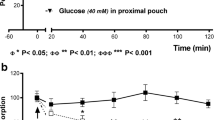Abstract
The role of capsaicin-sensitive sensory nerves in gastric mucosal blood flow (GMBF) responses to mild irritants was investigated in the rat stomach mounted on a lucite chamber using hypertonic NaCl and 0.2 N HCl. Exposure of the mucosa to hypertonic NaCl (0.5, 0.75, 1 M) for 10 min caused a reduction in the transmucosal potential difference (PD) in a concentration-related manner, followed by an increase of luminal pH and GMBF. In contrast, mucosal application of 0.2 N HCl caused no or little change in PD and pH, but increased GMBF significantly. Functional ablation of capsaicin-sensitive sensory nerves significantly inhibited the increase of GMBF after exposure to these irritants, although the PD and pH responses induced by 1 M NaCl remained unaltered by this treatment. Pretreatment with indomethacin (5 mg/kg, subcutaneously) significantly attenuated the GMBF responses to 1 M NaCl and 0.2 N HCl and inhibited the increase of pH caused by 1 M NaCl. Mucosal application of capsaicin (0.1 mg/ml for 10 min) produced an increase of GMBF without being accompanied by change in PH and pH, and this effect was significantly blocked by either indomethacin or chemical deafferentation. These results suggest that capsaicin-sensitive sensory nerves as well as endogenous prostaglandins may be involved in the mechanism of GMBF responses induced by mild irritants, and the latter might sensitize these nerves to mucosal irritation. PD reduction may be obligatory for pH but not GMBF responses.
Similar content being viewed by others
References
Holzer P, Sametz W: Gastric mucosal protection against ulcerogenic factors in the rat mediated by capsaicin-sensitive afferent neurons. Gastroenterology 91:975–981, 1986
Takeuchi K, Niida H, Matsumoto J, Ueshima K, Okabe S: Gastric motility changes in capsaicin-induced cytoprotection in the rat stomach. Jpn J Pharmacol 55:147–155, 1991
Holzer P, Lippe ITh: Stimulation of afferent nerve endings by intragastric capsaicin protects against ethanol-induced damage of gastric mucosa. Neuroscience 27:981–987, 1988
Holzer P, Pabst MA, Lippe ITh: Intragastric capsaicin protects against aspirin-induced lesion formation and bleeding in the rat gastric mucosa. Gastroenterology 96:1425–1433, 1989
Lippe ITh, Pabst MA, Holzer P: Intragastric capsaicin enhances rat gastric acid elimination and mucosal blood flow by afferent nerve stimulation. Br J Pharmacol 96:91–100, 1989
Matsumoto J, Ueshima K, Takeuchi K, Okabe S: Capsaicin-sensitive afferent neurons in adaptive responses of the rat stomach induced by a mild irritant. Jpn J Pharmacol 55:191–195, 1991
Holzer P, Livingston EH, Saria A, Guth PH: Sensory neurons mediates protective vasodilation in rat gastric mucosa. Am J Physiol 260:G363-G370, 1991
Nobuhara Y, Takeuchi K: Possible role of endogenous prostaglandins in alkaline response in rat gastric mucosa damaged by hypertonic NaCl. Dig Dis Sci 29:1142–1147, 1984
Takeuchi K, Ueki S, Tanaka H: Endogenous prostaglandins in gastric alkaline response in the rat stomach after damage. Am J Physiol 250:G842-G849, 1986
Takeuchi K, Yamakuni H, Nobuhara Y, Okabe S: Functional and morphological alterations in the rat stomach following exposure to hypertonic NaCl solution. Jpn J Pharmacol 42:549–557, 1986
Evangelista E, Maggi CA, Meli A: Lack of influence of capsaicin-sensitive sensory fibers on adaptive cytoprotection in rat stomach. Dig Dis Sci 33:1050–1051, 1988
Robert A, Nezamis JE, Lancaster C, Davis JP, Field SO, Hanchar AJ: Mild irritants prevent gastric necrosis through “adaptive cytoprotection” mediated by prostaglandins. Am J Physiol 245:G113-G121, 1983
Takeuchi K, Ishihara Y, Okada M, Niida H, Okabe S: A continuous monitoring of mucosal integrity and secretory activity in rat stomach: A preparation using a Lucite chamber. Jpn J Pharmacol 49:235–244, 1989
Esplugues JV, Whittle BJR: Morphine potentiation of ethanol-induced gastric mucosal damage in the rat. Gastroenterology 98:82–89, 1990
Yonei Y, Holzer P, Guth PH: Laparotomy-induced gastric protection against ethanol injury is mediated by capsaicin-sensitive sensory neurons. Gastroenterology 99:3–9, 1990
Whittle BJR, Higgs GA, Eakins KE, Moncada S, Vane JR: Selective inhibition of prostaglandin production in inflammatory exudates and gastric mucosa. Nature 284:271–273, 1980
Dunnett CW: A multiple comparison procedures for comparing several treatments with a control. Am J Stat Assoc 50:1096–1121, 1955
Esplugues JV, Ramos EG, Gil L, Esplugues J: Influence of capsaicin-sensitive afferent neurons on the acid secretory responses of the rat stomachin vivo. Br J Pharmacol 100:491–496, 1990
Holzer P, Livingston EH, Guth PH: Sensory neurons signal for an increase in rat gastric mucosal blood flow in the face of acid injury. Gastroenterology 101:416–423, 1991 (abstract)
Svanes K, Takeuchi K, Ito S, Silen W: Effects of destruction of gastric surface epithelium by hypertonic NaCl on endogenous formation of prostaglandins. Surg Forum 32:119–121, 1981
Sharkey KA, Williams RG, Dockray GJ: Sensory substance P innervation of the stomach and pancreas: Demonstration of capsaicin-sensitive sensory neurons in the rat by combined immunohistochemistry and retrograde tracing. Gastroenterology 87:914–921, 1984
Buck SH, Burks TF: The neuropharmacology of capsaicin: Review of some recent observations. Pharmacol Rev 38:179–226, 1986
Takeuchi K, Matsumoto J, Ueshima K, Okabe S: Role of capsaicin-sensitive afferent neurons in alkaline secretory response to luminal acid in the rat duodenum. Gastroenterology 101:954–961, 1991
Holzer P, Pabst MA, Lippe ITh, Peskar BM, Peskar BA, Livingston EH, Guth PH: Afferent nerve-mediated protection against deep mucosal damage in the rat stomach. Gastroenterology 98:838–848, 1990
Lundberg JM, Saria A: Polypeptide-containing neurons in airway smooth muscle. Annu Rev Physiol 49:557–572, 1987
Williams TJ, Morley J: Prostaglandins as potentiators of increased vascular permeability in inflammation. Nature 246:215–217, 1973
Esplugues JV, Whittle BJR: Prostaglandin protection of the rat gastric mucosa is attenuated by opioids. Gastroenterology 99:A-42, 1990
Woodbury DM: Analgesic-antipyretics, antiinflammatory agents, and inhibitors of uric acid synthesis; salicylates and congeners, phenacetin and congeners, antipyrine and congeners, indomethacin, colhicine, allopurinol.In The Pharmacological Basis of Therapeutics. LS Goodman, A Gilman (eds.) London, Macmillan, 1970, pp 314–347
Author information
Authors and Affiliations
Rights and permissions
About this article
Cite this article
Matsumoto, J., Takeuchi, K., Ueshima, K. et al. Role of capsaicin-sensitive afferent neurons in mucosal blood flow response of rat stomach induced by mild irritants. Digest Dis Sci 37, 1336–1344 (1992). https://doi.org/10.1007/BF01296001
Received:
Revised:
Accepted:
Issue Date:
DOI: https://doi.org/10.1007/BF01296001




